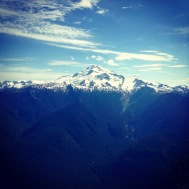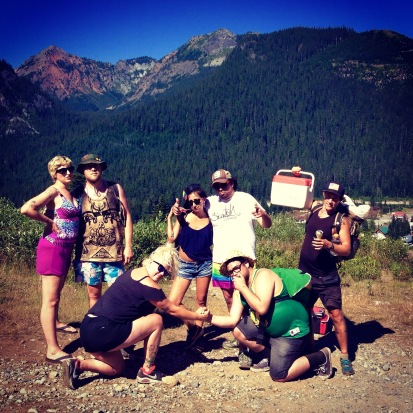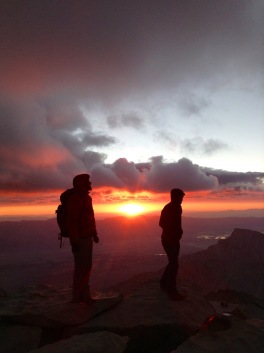
Hungarians like to drink. So do I… So I got along great in the land of breakfast beer and schnapps before AND after meals. Unicum is the national liquor – and herbal blend which kindof reminds me of one of my favorites from the States, Fernet Branca. And there are s wide variety of cheap, Ranier like tall cans available… Usually for about 230huf, or just under a buck. A 5cl shot of schnapps in a bar will set you back 500cl, or about $1.75. My kind of country!
Category Archives: travel
Landscapes of the Országos Kéktúra
Cephalapods & Other Budz on the Országos Kéktúra
Országos Kéktúra – the National Blue Trail of Hungary

The Hungarian flag emblem, and underneath the everpresent blue and white striped blaze of the Blue Trail
Touted as the oldest sanctioned walking route in Europe, the Országos Kéktúra makes a long loop around Hungary – traversing low mountains, ancient villages, rolling low hills of wheat and hay fields and extensive beech and other deciduous forest. Meandering on steep (Appalacian trail like) stone trail, rolling well groomed single track, seemingly unmaintained muddy forest trail, abandoned and active agricultural roads and some highway walking the tramp offers something significantly different from Harpo and my experience of walking the national scenic trails in the US.

Well groomed single track thru expansive beech forest
The road walking is kinda a bummer. After hiking for days on end thru high mountains in the Sierra, the green tunnel vibes, followed by a 5k pavement trek into town is a much different experience. This is offset by the fact that you can drink espresso every morning in some age old cafe, the bar tended by a patron only somewhat younger than the cobblestones that line the streets. And the energy, enthusiasm and kindness of the rural Hungarian people are unmatched. This is a kind of rural life we imagine with nostalgia in America, or even in Northern Europe (Huck reminds us – iz not like these even in Denmark anymore).

If the blazes lead to the vineyard, prolly you’re headed the right direction. The various colored blazes indicate different hiking routes.
The trail itself is exceptionally well marked – you’re in no danger of getting lost. There is also a set of GPS waypoints available that can be ported to Gaia or another GPS app. However, every time I had a question about routing, by the time I had my phone out of the holster I spied one of the distinctive blue and white striped blazes. Other blazes indicate side trails, ruins, loops, springs and other features of interest. And signs appear at every significant intersection with more information about sites, distances and prospective hiking times. As a bonus, every small town has several water pumps offering free, unchlorinated water which we drank unfiltered without problems.

Huck with that 100km stare over one of many endless hay fields we traversed
For all the road and village walking, the sections through the hilltop forest are clearly the highlight. While this is all managed forest, we see a model of what contemporary forestry practices can yield. While I’m kinda bummed about walking past stacked lumber, it’s clear that these dudes know the value in sustainability of their forests. There are no clearcuts, and the diversity of bird and insect life is unrivaled by anything I’ve seen in the States outside of the Hoh rainforest. There seems to be a decent balance between nature and industry…as a conservationist it’s hard for me to approve, but I appreciate the openness of the manicured forest, and the acres of groomed roads that allow me to access it.

The ‘mountains’ are really hills, but offer some exceptional views over the rural landscapes
The most significant different is the language barrier, of course. In the cities on Hungary everyone is exited to practice their English, but in the countryside English is met with blank (if not a little embarrassed) stares. That said, Harpo and I managed to maintain our vegan diet with little problem, and people are SUPER NICE. Like, really nice. And Huck was praising the availability of things like homemade liver pâté and paprika cured sausage in small villages – local products mostly unavailable in urban areas in the US or norther Europe. There’s always bread baked daily and farm fresh veggies; also local schnapps.

And then there are 100 year old ruins lost in the woods offering solace, a brief rest, and a look at graffiti from the 1800’s
We ended up hiking the OZT in mid May, which according to the English language tourist site for the trail can entail heavy rain. We mostly avoids the rain, and the heat of the sunny days makes me wonder if an August walk would be unbearable hit. Given the terrain, we were able to easily cover 25/30 km a day (15 – 18 miles) including morning coffee breaks and long lunches. We were always building our evening cook fire before sunset. And given the frequency of small villages, we never carried more than a days’ worth of food (wit some emergency ramen in case of national holiday or not realizing shops in small towns close at 1 pm). We found our 2 season gear totally sufficient for the time of year and elevation – I never needed my base layer except when I was washing my hiking clothes.
As tramps go, our short 350 km section of the Országos Kéktúra has been super fun, and inspires me to explore more of the Euorpoean walking routes. The OKT is part of a longer trail – E4 – one of a series of walks that connect existing regional trails into long form traverses of northern and Eastern Europe. The sense of stepping back in time, traveling through pre and postwar Europe and even into feudal times – the unimaginable past, before the detritus of global capital forever littered the landscape – is irreplaceable. The lack of McD’s and billboards allows breathing room unlike the rural landscapes in the US – and offer a new and different sense of exploration.
Flowers of the Országos Kéktúra
PCT Memories 2015
Wrong Way Gang on Si
We live in the future
This is my first blog post by email! I enjoy the respite from technology that our long walks provide. I intend to do more writing, and wish to share of these dispatches on our blog during our PCT journey. I recently discovered the WordPress “post by email” function – which should allow me to create posts with the iDevice in airplane mode. Then, when I have service or wifi in town, I can “send” these prefabricated posts to Songs Out of the City. Post by email seems to provide the same functionality as the web interface, including creating categories, tags etc.
Our AT method was creating posts including photos/stories when we were in town, which meant many of our town days were spent in front of an old/slow hostel computer trying to download/digest the last 7 days of activity. I was usually so exhausted I didn’t feel like posting or digesting anything. I’m hoping the WordPress post by email functionality will help my stories feel more immediate, since they will actually be written in real time.
I believe the plugin is still in beta, so I will let you know how it works out!
- screenshot: formatting functions available for post by email
- screenshot: instructions for post by email
AT vs PCT death match

East Coast Big Lady – Harpo & Groucho’s stealth spot on day 3 of their AT hike – Katahdin viewed from Rainbow Lake (July 2013)
Now that we’ve announced we’re hiking the Pacific Crest Trail this summer, we’ve been getting some questions about how this journey will differ from our 2013 AT thru hike. For honest journalisms-sake, we’ll have to give you an update on that when we finish. But for now here are some quick thoughts based on research and good ol’ fashioned hearsay:
Mileage
The PCT is just under 2700 miles, while the AT is just under 2200 miles.
Trail Condition
The PCT is graded and maintained for pack animals and thus has more switchbacks, nicer quality trail surface, and less scrambling. The PCT traverses through higher elevation mountains (10,000-14,000 footers as opposed to 4000-6000 footers), and so there may be some brief bits of snow travel, especially in the North Cascades in WA or Sierras in California, depending on when we get to those spots.

This is an example of the “trail” in Maine. A bare rock slab going straight up hill with crevices for foot/hand holds rendered slippery and useless by the frequent rain. The easiest way to get up, even with a 20lb pack, was literally to get a running start (i.e. sheer force of will.)
Elevation Change
We’ve seen varying numbers on the exact number of elevation gain/loss over time on the AT or PCT (or CDT for that matter). But we’ve been told by thru hikers of both treks that 30 miles on the PCT feels like 20 miles on the AT, because of trail quality and gentler elevation profiles. This recent blog post by reputable hiker/mapper Guthook (whose apps are fantastic BTW), suggests the following in this blog post:
Overall elevation gain/loss on Appalachian Trail: 917,760′ over 2185.3 mi (avg: 420’/mi)
Overall elevation gain/loss on Pacific Crest Trail: 824,370′ over 2668.8 mi (avg: 309’/mi).
Overall elevation gain/loss on Continental Divide Trail: 917,470′ over 3029.3 mi (avg: 303’/mi).

Harpo climbs a sleep & slippery talus slope, seemingly out of the clouds, towards Chairback Gap lean-to
Hiking Time
Who knows. Any number of things can impact how long a hike takes, including your personal pace, quality of terrain, elevation gain, your efficiency with hiking chores like water filtration or setting up your sleep system or eating, weather, length of hitching to resupply, amount of time spent in town resupplying, number of zero (non-hiking days) you take, injury/illness, trail closures due to fire, well… you get the point. But generally speaking, someone who has already thru hiked has figured out how to be efficient at hiking/camping, and so barring injury, illness, or other unexpected detours, we’ve heard that it might take 2-4 weeks LESS time to hike the PCT even though it has more miles, because of the aforementioned trail conditions and our previous experience. We’re thinking it will take 4-5 months.

time saver… we were contemplating hitching to town to go to the brewery/hostel and then some nice day hikers gave us trail magic – rejuvenating our spirits, saving us a trip to town and surreptitiously providing us several extra happy hours of hiking.
Traffic on Trail
Last year on the AT 653 Northbound thru hikers, and 76 Southbound thru hikers claimed to have finished the entire trail (about 20% of those who attempted it.) The PCT currently collects and publishes less data about thru hikers, but at least 336 people reported a completed thru hike in 2014 (the PCTA thinks about 50% of people who attempt a PCT thru hike finish.) Due to the cultural zeitgeist around thru hiking also fueled through the recent movies “Wild” about the PCT and “A Walk in the Woods” about the AT, traffic is increasing dramatically in recent years. However, most (like 80-90%) of those hikers begin their journeys in California and hike northbound (NOBO). Beginning in Washington and hiking southbound (SOBO) we expect significantly less thru hiker traffic on the trail than our AT experience. This should be good for our meditation practice 🙂
Views
The states of Maine and New Hampshire offer the only above-treeline hiking on the AT. While we experienced much beauty both in the NE and along the whole AT, we expect more epic vistas and geologic diversity on the PCT as we travel along ridge lines, maybe thru snow fields, in proximity of Rainer, Hood, Shasta and Whitney, and then thru the Sierras down into the desert near Joshua Tree.

West Coast Big Lady – Groucho’s stealth spot on a PCT section-hike – just inside the Rainier National Park (August 2014)
Water
For the first half of the AT, water was plentiful. We sometimes felt guilty even treating water because it was pouring cold and strong from a pure spring out the side of a mountain. Once we reached the halfway mark in Pennsylvania in September we started running into dry sources, needing to sometimes hike .5-1 mile off trail for water. This continued intermittently into Virginia and Tennessee until winter precipitation began.
On the PCT we’ll have a crazy different challenge when we get to the desert in the fall. We’ve heard about 30+ mile stretches without sources, and the need to carry 6-10 litres in the heat of the summer. Thankfully there is a frequently updated water report that we’ll be able to print out on a daily or weekly basis to help with our planning. If anyone sees a camel for sale on ebay or something, let us know…




























































